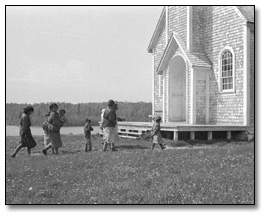
Scaffolding Lesson One: Making Sense of Primary Documents

Roman Catholic church at Sandy Lake, 1953
John Macfie
Black and white negative
Reference Code: C 330-8-0-0-3
Archives of Ontario, I0000182
The past is not easy to see or understand. Most people (very much like you did not create documents that tell us about their experiences, and even if they did, these records seldom survived through the ages.
To make things even more complicated, as we saw above, historians are not only interested in what individuals in the past perceived and understood about their lives; historians are also interested in larger and more general questions like, “what role did religious differences have in community formation?” questions that simply cannot be answered at the level of individual observation, or point of view.
While most historians would agree that it is impossible to provide a definitive answer to the question “What happened in the past?,” we can draw on a variety of sources (texts), and on the research and writing that has already been done (contexts) to create a better understanding of the people, events and relationships that we know about from the past.
This section examines some concrete ways of evaluating the quality, meaning and significance of any particular historical document in the process of “doing history.“
Step 1: Evaluate the quality of your historical document.
How do we measure the quality of a historical document? Its quality is dependent on three things: its authenticity, its scope, and its suitability to our research agenda. Here are some questions that can help you evaluate these elements:
- Is the historical origin and archival location of the document identified? Why does this matter?
- How do you know that your document is authentic, i.e. what it claims to be?
- Is the information that it contains complete, or are pieces of information missing? Are they illegible? How could an incomplete document, or an incomplete series of documents, influence your research findings?
- Any single document does not provide us with enough evidence to make reasonable conclusions about the past. What other documents on the same subject, time period or about the same person, issue or event should you read to get a better understanding?
Step 2: Assess the kind of information the document contains
Every historical document gives us a snapshot of the past that provides some kind of information. Before we can understand what, exactly, a snapshot is showing us, however, we need to know something about where, when, why and by whom it was taken. We need a context for understanding its existence before we can understand its meaning.
Both a personal letter from 1881 and a census from the same date might, for example, contain information of great use to a researcher. A letter gives us an excellent view of how a single individual experienced and felt about the overview of certain (and limited) kinds of behaviors. The kind of information that they contain about the past is, however, very different; using the census to explore an individual’s emotional experience of settlement, for example, is not likely to yield much success.
To the extent that we know and understand a) the context in which a document was created, b) the purposes for which it was created and c) our own research questions, we can understand and evaluate the kind of information it gives us about the past.
The evidence contained in the document can be further interrogated with the following:
This document provides a good source of information about some aspects of the past.
- List three questions about the past that your document answers well.
- List three questions about the past that the document addresses poorly, or not at all.
- How would your opinion of this source change if you knew if was created by
a) a corrupt bureaucrat
b) a writer of historical fiction
c) an inmate of a lunatic asylum? - How would your opinion of this source change if you knew it was created for
a) an advertising campaign
b) a theatre production
c) the government of Canada?
Step 3: Evaluate the significance of the document to your historical argument.
Even though a document is authentic, complete and well contextualized, it still might be useless for historical research. This is because the significance of any historical document is ultimately dependent on the skilled and appropriate use that the historian makes of it.
The knowledge that researchers have of their general subject area helps them to frame questions about the past that are significant to current debates and interests. Their skill in thinking reasonably, logically, and creatively helps them to determine whether any particular source is a suitable one for answering familiar or new questions about the past.
The following questions provide some ways of evaluating the historical significance of your document:
- What makes this document particularly suitable to the research you are doing?
- Does the kind of information provided by your document answer the questions you are asking?
- Does the information contained in this document support or contradict the findings of other historians? How?
- If your research is on a new topic or unexplored area, how does it fit in with other research in a related geographical or subject area?
- Do you need to consult more sources, more types of sources, or the findings of other historians to support the points you are making with this evidence?